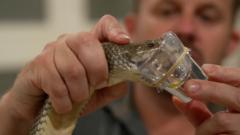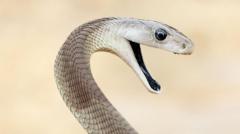At the Australian Reptile Park, dedicated teams are on a mission to milk venom from deadly species like Sydney funnel-web spiders and King Brown snakes. Their efforts not only highlight the dangers of these creatures but also reveal how they contribute to lifesaving antivenoms, ensuring a safer coexistence with nature in Australia.**
The Lifesavers Among Us: How Australia's Deadly Creatures Fuel Antivenom Production**

The Lifesavers Among Us: How Australia's Deadly Creatures Fuel Antivenom Production**
In Australia, the most venomous animals are critical to saving human lives through a unique antivenom program.**
In a bustling room at the Australian Reptile Park, Emma Teni is seen skillfully extracting venom from the notoriously dangerous Sydney funnel-web spider. With bright pink tweezers in one hand and a pipette in the other, she carefully manages to collect the potent venom crucial for creating antivenom.
Each day, Emma milks around 80 funnel-web spiders, housed in carefully organized shelves within the facility. These spiders are infamous; their venom can kill within minutes, yet thanks to this antivenom program, there haven't been any fatalities since it started in 1981. Public participation plays a vital role in the initiative, as everyday Australians bring in specimens they find, often through local veterinary practices or various drop-off points around the city.
The program's importance is underscored by Emma's efforts to ensure these spiders are safely captured, rather than killed. “We want people to understand the significance of these creatures; they're deadly, yes, but they can save lives,” she asserts, pointing out that after a spider is safely delivered, it can directly contribute to medication that saves lives.
Similarly, the operations at the Reptile Park are not limited to spiders. Billy Collett, operations manager, describes his work collecting venom from King Brown snakes, regarded as one of the most venomous snakes in the world. Utilizing precise techniques to extract venom, Billy remarks on the snake's behavior, emphasizing that their bites are only likely when provoked.
The extracted venom is then transported to labs where it undergoes extensive processing. This involves injecting controlled doses of the venom into large animals, like horses and rabbits, to boost their immune response and develop the necessary antibodies for antivenom production. The process can take up to 18 months to yield usable medicine, but the impact is profound—CSL Seqirus, the company responsible for the production, provides around 7,000 vials of various antivenoms each year.
As communities are educated about the importance of these creatures, the Reptile Park also seeks to expand access to antivenom, particularly in remote areas and countries like Papua New Guinea, where dangerous snake species are prevalent. Through this endeavor, the antivenom program has reportedly saved over 2,000 lives.
Amidst the seriousness of snake bites and toxic spiders, both Emma and Billy maintain a light-hearted attitude about their work. They encourage a deeper understanding of these creatures and promote coexistence rather than fear. As Emma humorously reflects, “Some girls get flowers; I get spiders in jars,” highlighting the unique relationship Australians have with their local wildlife.
Through awareness and careful handling, the narrative around Australia’s deadly animals is shifting from one of fear to appreciation. In a country where every corner seems inhabited by something deadly, the ongoing efforts in venom collection and antivenom production represent a remarkable intersection of danger and lifesaving medicine.


















